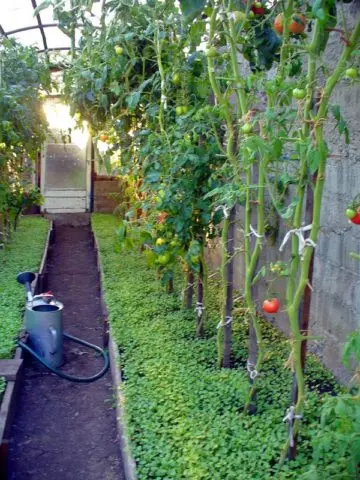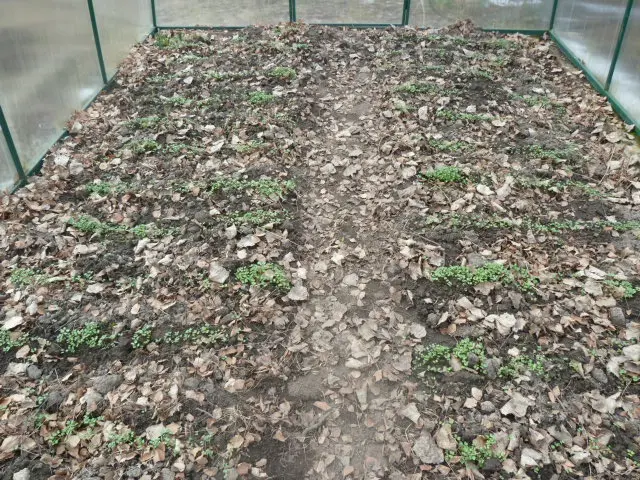Contents
Green manure is a type of green plants that have a positive effect on the soil and nourish it. With proper planting and care, they are able to nourish the soil better than common organic matter. At the same time, these herbs are safe. This is especially important for a greenhouse, where, over time, its own closed microclimate is created, and without additional top dressing, the soil quickly becomes poorer. Green manure in the greenhouse in the fall is an excellent solution for enriching the soil with nutrients.

Is it possible to sow green manure in a greenhouse
Green manure in the greenhouse is simply necessary to sow. Over time, even with optimal soil care, mineralized soil with its own negative microflora forms in the greenhouse. This significantly reduces the yield. Changing the soil in a greenhouse is troublesome and not always advisable. Therefore, experts recommend sowing biological fertilizer in the fall to improve the soil in greenhouse conditions.
Benefits of planting green manure in a greenhouse
There are several main advantages of using greens over organic fertilizers, in particular, manure:
- Economical. To get the same result from organic fertilizers, you will have to spend a lot of money, since fertilizers will need a lot.
- There is no risk of introducing weeds, as with the application of manure or humus.
- Such plants successfully fight many pests.
- Green fertilizers successfully resist most diseases.
- With their root system, plants loosen the soil, which has a positive effect on its oxygen supply.
This is a much cheaper and safer way to renew the greenhouse soil and increase yields. Sowing green manure before winter in a greenhouse will help protect seedlings in early spring from the negative effects of the first spring rays of the sun.
When to sow green manure in the fall in a greenhouse
For sowing biological fertilizer in the fall, a not too cold period is chosen. It is advisable to do this in September, after the main harvest. The second stage of sowing is just before winter, in November.
Green fertilizers sown in September will have time to sprout before frost, and then they can be left until spring and not mowed. And the plantings that were sown in November will sprout in the spring. In this case, they must be mowed before flowering and thus preserved in the soil. This is a great method for those who grow early varieties of tomatoes and cucumbers in the country. It is useful to sow green manure in a greenhouse in autumn twice: in September and in November. This will preserve the yield and disinfect the soil. But they must be different plants.

What green manure to plant in a greenhouse in autumn
More than 400 species of plants can act as green manure. What specific fertilizer to plant in the autumn in a greenhouse depends on the timing of planting and on the crop that will then be grown in the greenhouse, as well as the desired effect. To enrich the soil with nitrogen, it is necessary to plant legumes:
- shouting;
- peas;
- clover;
- beans;
- beans;
- lentils;
- bottom
If they decide to plant before winter, then it is advisable to take cold-resistant crops, for example, vetch, rye, oats or rapeseed.
Mustard will perfectly protect the land in the greenhouse from pests and weeds. Oats will enrich the soil with potassium and phosphorus. Planting green manure in a greenhouse in the fall is an inexpensive and safe way to protect crops from pests and diseases, as well as nourish the soil.
Phacelia is considered a universal green manure for all occasions. This version of green manure is not afraid of either cold or drought. At the same time, the plant has a decorative appearance, repels fungus, fights nematodes and aphids.
For tomatoes, peppers and eggplants
Each crop requires a certain nutritional value of the soil, and is also susceptible to various diseases and pests. Therefore, when choosing a green fertilizer, it is recommended to focus on the crop, which will then be grown in this greenhouse. So it will be possible to choose the best option. Crops such as peppers, eggplant, and tomatoes leave nothing useful after a bountiful harvest in the soil. The soil becomes literally empty, and therefore planting green fertilizer will be most justified if these crops are planted again next year in the greenhouse.
The best option for planting in autumn will be green manure crops: oats, rye, barley. They will give the soil potassium. A lack of potassium will cause tomatoes to be small, bloom late, and yields will drop significantly.
And also before winter for tomatoes and peppers, it is good to plant phacelia. It will bring the acidity of the soil back to normal. You can also use the mixture, alternating oats with vetch and rapeseed.
For cucumbers
Oats as green manure in the fall in a greenhouse are good for planting for cucumbers. This will help enrich the soil with nitrogen, as well as completely improve the soil. Since cucumbers strongly “suck out” useful elements from the soil, it is useful to plant legumes in the fall: lupins, beans, as well as clover and vetch. After these crops, the yield of cucumber will increase significantly.
It does not hurt to sow mustard for pest control and soil disinfection. Among green manure sown in autumn, mustard in a greenhouse is of particular importance due to the sulfur that is in its root system. This will help to avoid the invasion of the wireworm.

For other cultures
If it is planned to plant garlic in the greenhouse, then it is not recommended to use legumes as green manure. The best option for fertilizer is phacelia and mustard.
For carrots, radish, mustard and rapeseed are suitable as fertilizer. In principle, this culture is not so capricious and will grow well after any green manure.
Cabbage and radishes do well after cereals and most legumes.
How to sow green manure
To obtain the optimal result, it is important to follow the rules of agricultural technology that are provided for green manure. For landing, the following algorithm of actions is used:
- If possible, remove weeds and dig the soil in the greenhouse.
- The place of sowing must be thoroughly watered so that the soil is sufficiently moist.
- Each green manure has its own sowing instructions, which are described in detail on the packaging. Most often, seeds simply need to be scattered in the right amount on the surface of the soil. At the same time, it is important that for plants planted before winter, the number of seeds sown increases, since some of them may not sprout in the spring.
- Level the soil surface with a rake or nail with a flat shovel. It is not necessary to bury green manure in the ground, but you can sprinkle a small amount of humus if you wish.
- In order to prevent useful green manure from turning into harmful weeds, during flowering, it is necessary to cut flower stalks so that seeds do not appear and spray.
These are the basic rules for sowing green manure. Usually in care, these plants are not capricious and easily adapt to a wide variety of agricultural conditions.
Green fertilizers can be planted three times a year: in spring, autumn, summer. Each of these landings has its own benefits. The most commonly used are various types of green fertilizers. In autumn, mainly rapeseed, rye, vetch, white mustard and oats are planted.
For spring, cold-resistant plants are most suitable, which will easily endure the first spring frosts and have time to sprout before sowing seedlings in the greenhouse. Up to this point, you need to have time to mow green fertilizer at least once. These are rye, oats, mustard and phacelia.
A few tips for beginner gardeners
The most important thing that a gardener should take into account when sowing biological fertilizer is that these plants should not produce seeds and be sown in the garden. Otherwise, a banal weed will form in the greenhouse, which will interfere with the growth of cultivated plants with all its might, and instead of benefit, there will be a huge amount of trouble for the subsequent removal of a useful plant from the greenhouse. Therefore, it is important to mow green manure on time. This is usually done at the moment when the grass reaches 30–40 cm and does not begin to bloom. This is the best option, since green plants will rot and saturate the soil with additional nutrients.
You can not use the same green manure throughout the season and for any plant. What is a good precursor for tomatoes is not suitable for a greenhouse where cabbages or peas are grown.
With timely spring planting, green manure can protect fragile seedlings from the first bright sunlight.
Each type of green manure has its own landing features that should be considered:
- legumes do not like acidic soil;
- dyeing woad perfectly tolerates any temperature changes and perfectly tolerates a lack of moisture;
- vetch – demanding fertilizer, which is best planted interspersed with cereals, since vetch needs support for a climbing stem;
- white mustard will scare away the bear, perfectly fights late blight, which is so dangerous for most cultivated plants.
If all these nuances are taken into account and biological helpers are not allowed to multiply, then the soil in the greenhouse will not be able to turn into mineralized soil and the yield of cultivated plants will always be at a high level.

Conclusion
Green manure in a greenhouse in autumn can be planted twice, but even one full-fledged planting with the right agricultural technology will allow the gardener to get an unprecedented crop of cultivated plants the very next year. It is important to choose the right specific green fertilizer, as well as mow it in time so that a useful product does not turn into a weed. Recently, this method of soil fertilization has become increasingly popular, especially since it does not require significant economic costs.









